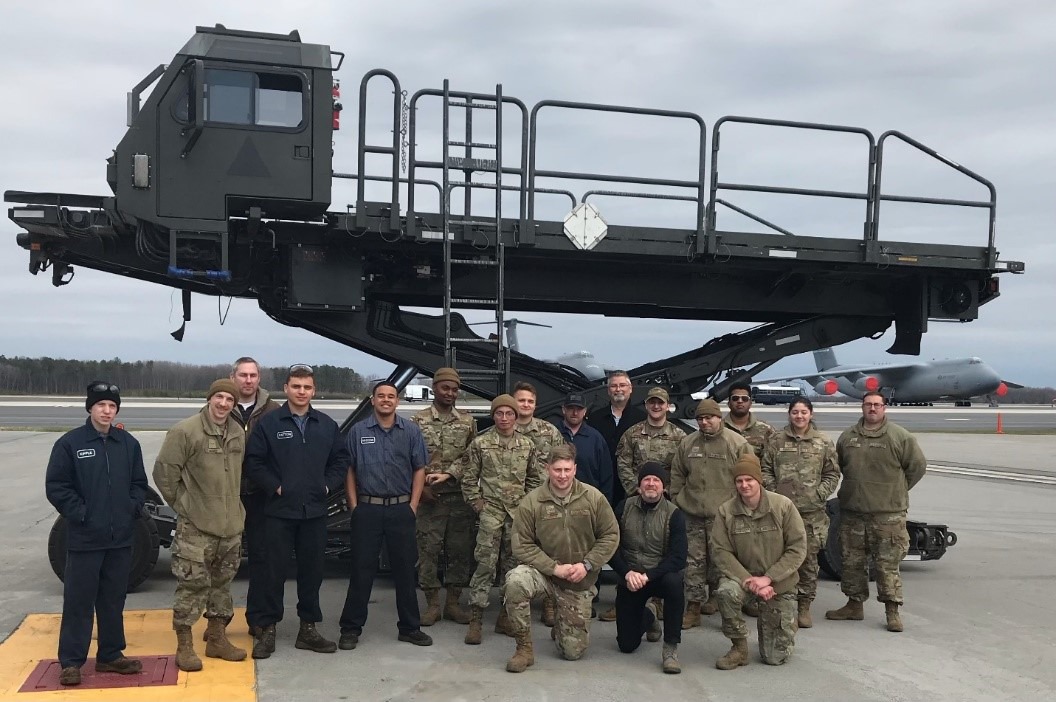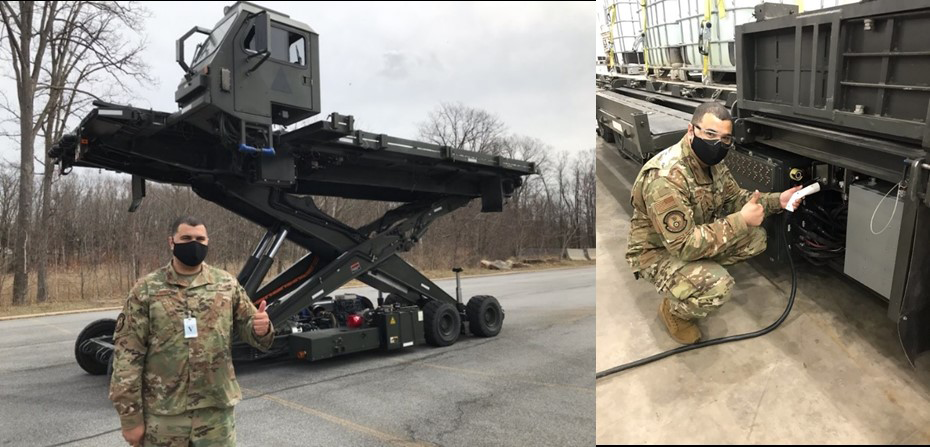WRIGHT-PATTERSON AIR FORCE BASE, Ohio (AFRL) — The Air Force Research Laboratory is leading a Department of the Air Force effort to develop and test a diesel-electric mobility aircraft cargo loader, the hybrid Halvorsen prototype.
Airlift and flightline cargo loading are critical for military operations and worldwide humanitarian missions. For successful operations and missions, a strong cargo supply backbone is a necessity. Mobility aircraft cargo loading generally relies on two worldwide deployable flightline weapon system vehicles, the Tunner 60K and the Halvorsen 25K.
Presently, continuously running diesel engines power the USAF’s primary aircraft loaders. However, the worldwide environment is changing, and a small USAF Vehicle Loader Team has been preparing for a more electrified future. This team recently completed the hybrid Halvorsen prototype and obtained operator and maintainer feedback at Air Mobility Command’s Dover and Joint Base Charleston Aerial Ports.
The hybrid Halvorsen prototype is an AFRL-led effort that includes the office of the Assistant Secretary of the Air Force for Energy, Installations and Environment; Headquarters, Air Mobility Command’s A4 Logistics, Engineering and Force Protection Directorate; the Air Force Life Cycle Management Center’s Agile Combat Support Program Executive Office; the 441st Vehicle Support Chain Operations Squadron at Joint Base Langley-Eustis, Virginia; and industry partners Concurrent Technologies Corporations and SAFT.
Chief Master Sgt. Troy Saunders, now retired USAF vehicle career fleet manager, launched the initiative for the Halvorsen prototype. He envisioned the best future flightline vehicles would be electric and the USAF need to start preparing for that future. The Future Force Energy and Power Office at AFRL’s Materials and Manufacturing Directorate took the lead to organize the team, develop the prototype and obtain maintainer and operator feedback in order to draft technical specifications for the next generation aircraft loader acquisition.
“This was a game-changing proof of concept that links a strong history of diesel-based global power projection with new electrification technologies … it revolutionizes the future vision for flightline vehicle and weapon systems capabilities,” said Chief Master Sgt. Patrick Kelleher, USAF vehicle fleet manager with 441st VSCOS.
“We wanted to put this prototype in the hands of the mechanics and drivers to get their feedback – they liked it and they were impressed – more than I anticipated,” said Tim Clear, Halvorsen weapon system manager at HQ Air Mobility Command “It proved that the electric-based performance was as good as or better than the diesel-based performance.”
While Dover and Charleston evaluation teams had favorable reviews of the hybrid Halvorsen’s performance, the USAF is working technical details that are still under evaluation.
“Battery capacity, charging times and modernization strategy are still concerns that we need to work through,” Clear explained. “But after seeing the results of this project, a more electric aircraft loader could be in our future.”
Prototype projects like the hybrid Halvorsen are critical to leading change and transformation for future endeavors.
“The development of the hybrid Halvorsen loader prototype and successful operational evaluations were valuable,” said Rob Woodruff, a lead engineer from the program office at Robins AFB. “The electric drive provides significantly less noise during driving, loading and lifting operations, and enables a reduction in fossil fuel usage. We will use this learning as we modernize our vehicle fleet.”
Tom Layne, AFRL project lead, said programs such as this encourage leaders to consider the future force.
“Projects like this allow our enterprise leaders at all levels to come together, work through challenges, make decisions and critically evaluate the hits and misses … mechanics are just as critical as engineers in these projects,” Layne said. “These leaders go back to their organizations, interact with their colleagues … The intellectual power multiplies as well as the acceptance of new technology.
“One of the most critical decisions we made together was to integrate the SAE J1772 Interface Standard for vehicle and equipment battery charging commonality and interoperability on the flightline” Layne added “We believe this will have a very large impact on our defense and national aviation infrastructure and industry.”
For more information about the hybrid Halvorsen project, please email AFRL.RXSC.APTO@us.af.mil or call 937-674-5046.
About AFRL
The Air Force Research Laboratory (AFRL) is the primary scientific research and development center for the Department of the Air Force. AFRL plays an integral role in leading the discovery, development, and integration of affordable warfighting technologies for our air, space, and cyberspace force. With a workforce of more than 11,500 across nine technology areas and 40 other operations across the globe, AFRL provides a diverse portfolio of science and technology ranging from fundamental to advanced research and technology development. For more information, visit: www.afresearchlab.com.

Hybrid Halvorsen Prototype evaluation team at Air Mobility Command’s Dover Aerial Port.

Hybrid Halvorsen evaluation team at Air Mobility Command’s Joint Base Charleston Aerial Port in South Carolina.

Master Sgt. Ryan Young, lead Halvorsen mechanic, 441st Vehicle Support Chain Operations Squadron, signals acceptance of the Hybrid Halvorsen prototype design, operational performance and charging interface.

The Hybrid Halvorsen prototype at Concurrent Technologies Corporation during contractor testing.

Hybrid Halvorsen prototype operator evaluating precision maneuvering at Air Mobility Command’s Joint Base Charleston Aerial Port in South Carolina.

